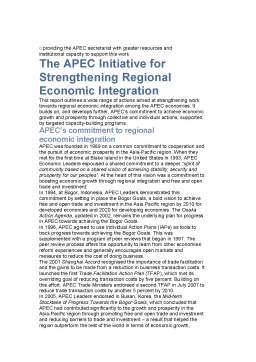Extras din proiect
The Asia-Pacific Economic Cooperation (APEC) forum was established in 1989 to capitalize on the growing interdependence of Asia-Pacific economies. By facilitating economicgrowth, intensifying economic and technical cooperation and enhancing a sense ofcommunity, APEC aims to create greaterprosperity for the people of the region.
APEC is a unique forum, operating on the basis of open dialogue and respect for theviews of all participants. There are no binding commitments; compliance is achieved through discussion and mutual support in the formof economic and technical cooperation. InAPEC, all economies have an equal say and decision-making is reached by consensus.Since its inception, APEC has grown to become one of the world's most important regional groupings. Its 21 member economiesare home to more than 2.6 billion peopleand represent approximately 56% of worldGDP and 49% of world trade.*(Source: The WorldBank and The APEC Region Trade and Investment 2006)APEC is the most economically dynamic regionin the world. Building on the five-year targetset in Shanghai in 2001 to reduce trade transaction costs by 5%, APEC member economies have targeted a further 5% reduction by 2010.
The forum constantly adapts itself to enable members to discuss important new economic challenges. These include facilitating electronic commerce, addressing the digital divide,countering terrorism and introducing measures to safeguard against infectious diseases.
What s Asia-Pacific Economic Cooperation?
Asia-Pacific Economic Cooperation, or APEC, is the premier forum for facilitating economic growth, cooperation, trade and investment in the Asia-Pacific region .
APEC is the only inter governmental grouping in the world operating on the basis of non-binding commitments, open dialogue and equal respect for the views of all participants. Unlike the WTO or other multilateral trade bodies, APEC has no treaty obligations required of its participants. Decisions made within APEC are reached by consensus and commitments are undertaken on a voluntary basis.
APEC has 21 members - referred to as "Member Economies" - which account for approximately 41% of the world's population, approximately 56% of world GDP and about 49% of world trade.
APEC's 21 Member Economies are Australia; Brunei Darussalam; Canada; Chile; People's Republic of China; Hong Kong, China; Indonesia; Japan; Republic of Korea; Malaysia; Mexico; New Zealand; Papua New Guinea; Peru; The Republic of the Philippines; The Russian Federation; Singapore; Chinese Taipei; Thailand; United States of America; Viet Nam.
Purpose and Goals
APEC was established in 1989 to further enhance economic growth and prosperity for the region and to strengthen the Asia-Pacific community.
Since its inception, APEC has worked to reduce tariffs and other trade barriers across the Asia-Pacific region, creating efficient domestic economies and dramatically increasing exports. Key to achieving APEC's vision are what are referred to as the 'Bogor Goals' of free and open trade and investment in the Asia-Pacific by 2010 for industrialised economies and 2020 for developing economies. These goals were adopted by Leaders at their 1994 meeting in Bogor, Indonesia.
Free and open trade and investment helps economies to grow, creates jobs and provides greater opportunities for international trade and investment. In contrast, protectionism keeps prices high and fosters inefficiencies in certain industries. Free and open trade helps to lower the costs of production and thus reduces the prices of goods and services - a direct benefit to all.
APEC also works to create an environment for the safe and efficient movement of goods, services and people across borders in the region through policy alignment and economic and technical cooperation.
Since its inception, APEC has worked to reduce tariffs and other trade barriers across the Asia-Pacific region, creating efficient domestic economies and dramatically increasing exports. Key to achieving APEC's vision are what are referred to as the 'Bogor Goals' of free and open trade and investment in the Asia-Pacific by 2010 for industrialised economies and 2020 for developing economies. These goals were adopted by Leaders at their 1994 meeting in Bogor, Indonesia.
Free and open trade and investment helps economies to grow, creates jobs and provides greater opportunities for international trade and investment. In contrast, protectionism keeps prices high and fosters inefficiencies in certain industries. Free and open trade helps to lower the costs of production and thus reduces the prices of goods and services - a direct benefit to all.
APEC also works to create an environment for the safe and efficient movement of goods, services and people across borders in the region through policy alignment and economic and technical cooperation.
APEC operates as a cooperative, multilateral conomic and trade forum. Member conomies take individual and collective actionsto open their markets and promote economic growth.
Preview document
Conținut arhivă zip
- Apec in Engleza.doc


































